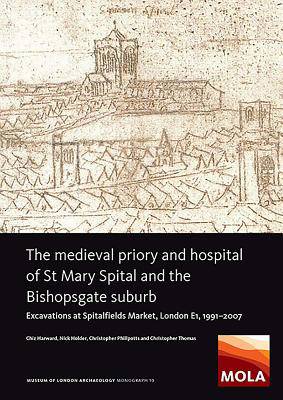
- Retrait gratuit dans votre magasin Club
- 7.000.000 titres dans notre catalogue
- Payer en toute sécurité
- Toujours un magasin près de chez vous
- Retrait gratuit dans votre magasin Club
- 7.000.0000 titres dans notre catalogue
- Payer en toute sécurité
- Toujours un magasin près de chez vous
The Medieval Priory and Hospital of St Mary Spital and the Bishopsgate Suburb
Excavations at Spitalfields Market, London E1, 1991-2007
Chiz Harward, Nick Holder, Christopher Phillpotts, Christopher Thomas
53,95 €
+ 107 points
Description
London's Spitalfields Market was the location of one of the city's largest archaeological excavations, carried out by MOLA between 1991 and 2007. This book presents the archaeological and documentary evidence for medieval activity here, on the north-eastern fringe of the historic city, and the site of the Augustinian priory and hospital of St Mary without Bishopsgate, later known as St Mary Spital. Large areas of the medieval precinct have been explored, making this by far the most intensively investigated medieval hospital, and one of the most extensively investigated monastic establishments, in Britain. Founded in 1197, rebuilt on a larger scale and refounded in 1235, the hospital catered primarily for London's sick poor. A pre-existing extramural and extraparochial cemetery became the priory's principal cemetery. As the priory continued to attract patrons and wealth, it expanded its precinct and carried out major building programs.
By the 15th century the small hospital had become one of the largest Augustinian priories in southern England. Medical treatment in the 14th century is illustrated by remarkable evidence from the canons' infirmary with its attached pharmacy; a trend towards secularization in the 14th and 15th centuries is shown by the hamlet of timber houses and workshops that grew around the cemetery. An exceptional survival was the charnel crypt of the 14th-century cemetery chapel, which is preserved today under Bishops Square.
By the 15th century the small hospital had become one of the largest Augustinian priories in southern England. Medical treatment in the 14th century is illustrated by remarkable evidence from the canons' infirmary with its attached pharmacy; a trend towards secularization in the 14th and 15th centuries is shown by the hamlet of timber houses and workshops that grew around the cemetery. An exceptional survival was the charnel crypt of the 14th-century cemetery chapel, which is preserved today under Bishops Square.
Spécifications
Parties prenantes
- Auteur(s) :
- Editeur:
Contenu
- Nombre de pages :
- 315
- Langue:
- Anglais
- Collection :
- Tome:
- n° 59
Caractéristiques
- EAN:
- 9781907586484
- Date de parution :
- 12-02-20
- Format:
- Livre relié
- Format numérique:
- Genaaid
- Dimensions :
- 213 mm x 297 mm
- Poids :
- 1542 g

Les avis
Nous publions uniquement les avis qui respectent les conditions requises. Consultez nos conditions pour les avis.






